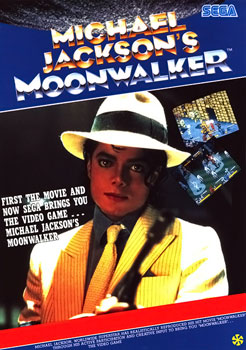Sega arcade version
| Michael Jackson's Moonwalker | |
|---|---|
 European arcade flyer | |
| Developers | Sega Triumph |
| Publisher | Sega |
| Producer | Michael Jackson |
| Composer | Tohru Nakabayashi |
| Platform | Arcade |
| Release | |
| Genres | Beat 'em up, run-and-gun |
| Modes | Single-player, multiplayer |
| Arcade system | Sega System 18 |
Michael Jackson's Moonwalker [a] is an arcade video game by Sega (programming) and Triumph International (audiovisuals), with the help of Jackson which was released on the Sega System 18 hardware. The arcade has distinctively different gameplay from its computer and console counterparts, focusing more on beat 'em up gameplay elements rather than platform gameplay.
Gameplay
The game is essentially a beat-em-up that is drawn using isometric video game graphics, although Jackson attacks with magic powers instead of physical contact, and has the ability to shoot short-ranged magic power at enemies. The magic power can be charged by holding the attack button to increase the range and damage of the magic power while moonwalking. If up close to enemies, Jackson executes a spinning melee attack using magic power.

If the cabinet supports it, up to three people can play simultaneously. [4] All three players play as Jackson, dressed in his suit (white for player 1, red for player 2, black for player 3).
Jackson's special attack is termed "Dance Magic". There are three different dance routines that may be performed, namely the dance routines from Smooth Criminal, Beat It and Billie Jean. The player starts with one to three of these attacks per credit (depending on how the machine is set up).
Bubbles, Michael's real-life pet chimpanzee, appears in each level. Once collected or rescued, Bubbles transforms Michael into a robotic version, with the ability to shoot laser bursts and missiles and absorb significantly more damage.
Development
In 1988, Michael Jackson contacted Sega about developing a video game that would capture his persona. Sega and Jackson then began working on an arcade video game based on his Moonwalker film and "Smooth Criminal" music video released that year. A prototype unit was demonstrated at Mexico's American Amusement Machine Association (AAMA) exhibition in early July 1990. [5] Jackson assisted Sega's game designers on the development of the game. [4]
Reception
In North America, the game had a successful launch. [4] It was the top-grossing new video game on the RePlay arcade charts in September 1990. [6]
The game received a positive review from RePlay magazine. [4]